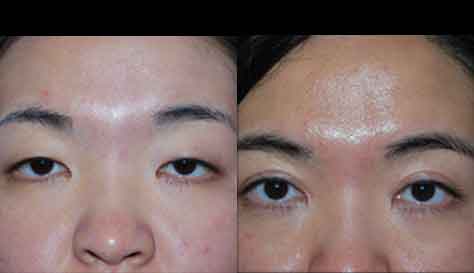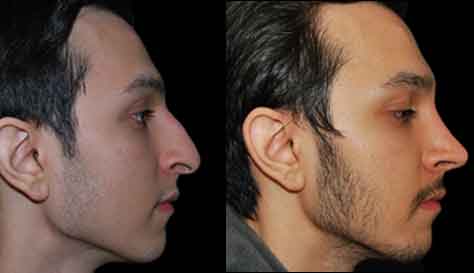Brow Lift
Conveniently located to serve the areas of New Jersey and New York

A Brow Lift, also known as a forehead lift or browplasty, is a surgical procedure used to elevate a drooping eyebrow that may obstruct vision and/or to remove the deep “worry” lines that run across the forehead. Brow lifts can revitalize drooping or lined foreheads, helping you to look less angry, sad or tired.
Brow lift is performed under general anesthesia and is often a part of several rejuvenating procedures performed in one operating day. Dr. Ovchinsky commonly combines brow lift with an eyelid lift (blepharoplasty) or facelift to maximize improvement around the eye area. With the use of the endoscopic technique, Dr. Ovchinsky will make several small incisions within the hairline and will use a scope to help free up the forehead skin and the brows. Dr. Ovchinsky will then lift up the brows and forehead to a higher, more youthful level and will secure them using sutures or a special anchoring device (Endotine).
What’s great about the endoscopic forehead lift technique is that it doesn’t require an incision all the way across the forehead and scalp; thus, the hair is preserved, which is an important consideration for most patients. For about one week after surgery, there may be some swelling and bruising. Pain and discomfort are usually minimal.
So, if your face has a droopy, exhausted look because of deep wrinkles between your brows or sagging eyebrows or forehead, you can probably benefit from a brow lift, which can make a major difference in your appearance.
Contents
- 1 Schedule Your Consultation
- 2 FAQ
- 2.1 What is a Brow lift?
- 2.2 How is a brow lift performed?
- 2.3 Who is a good candidate for a brow lift?
- 2.4 Are there any limitations to what a brow lift can achieve?
- 2.5 What type of anesthesia is used during a brow lift?
- 2.6 How long is the surgery?
- 2.7 What happens during my consultation with Dr. Ovchinsky?
- 2.8 What do I need to avoid before surgery?
- 2.9 What about my daily medications before surgery?
- 2.10 What happens on the day of surgery?
- 2.11 What happens after surgery?
- 2.12 What is the recovery like after a Brow Lift?
- 2.13 Are there any dietary restrictions following surgery?
- 2.14 When can I shower / take a bath?
- 2.15 When will my stitches be taken out?
- 2.16 When will I be able to work?
- 2.17 How soon will I be able to exercise?
- 2.18 When Will I be able to see results?
- 2.19 How long should the results last?
- 2.20 What are the potential Risks with this type of surgery?
- 2.21 Does insurance cover the cost of browlift surgery?
- 2.22 What is special about the way Dr. Ovchinsky does surgery?
Schedule Your Consultation
Interested in learning more about the brow lift surgery? Contact our office to schedule your initial consultation with Dr. Alexander Ovchinsky and begin your journey to a brand new you.
FAQ
What is a Brow lift?
The Brow lift, also known as a forehead lift, is a plastic surgery procedure designed to rejuvenate the upper one-third of the face and the eyebrow. The brow lift can elevate and re-shape the brow to improve brow position and relieve the heaviness or drooping of the brow/ upper eyelid complex.
How is a brow lift performed?
Nowadays, brow lift surgery is commonly done endoscopically through several small incisions within the hair. Usually, 4-5 small scalp incisions are made, 2-3cm each. The incisions are placed within the hair so that the resultant scars are well camouflaged. The hair doesn’t need to be shaved for the procedure. Through these access incisions, the forehead skin and the brows are mobilized and lifted as a unit. Two small absorbable fixator devices with small hooks are used to support the forehead in an elevated position. These devised are not visible externally, and they resorb gradually over 3-4 months. The hairline incisions are usually closed with absorbable sutures.
Who is a good candidate for a brow lift?
Both men and women in good health are candidates for a brow lift. Most commonly, the procedure is performed on the patients over the age of 40, but even some younger patients with genetically low set brows may consider the procedure. Very frequently, a patient presents for a facelift or blepharoplasty with the complaint of looking tired, sad, or angry when they are not. If the brow is low toward the middle of the forehead, it gives an angry appearance; if the brow is low toward the outside, it gives a tired and aged look. These can be dramatically improved by simply lifting the brow.
Are there any limitations to what a brow lift can achieve?
The primary goal of brow lift surgery is to elevate the sagging eyebrows. While it usually helps to decrease the upper eyelid hooding and skin redundancy, many patients will also need blepharoplasty (eyelid lift) in addition to brow lift to fully remove skin excess and rejuvenate upper eyelids. Also, endoscopic brow lift usually doesn’t correct brows asymmetry as the whole forehead is elevated as one unit and it is almost impossible to pull one brow significantly more than the other.
What type of anesthesia is used during a brow lift?
A brow lift is commonly performed under general anesthesia, although IV sedation can be used as well. A temporal brow lift, a more limited procedure where only outer (lateral) part of the brow is lifted, can be also performed under local anesthesia.
How long is the surgery?
A brow lift takes approximately 1.5- 2hrs. If combined with other facial rejuvenating procedures, such as eyelid lift (blepharoplasty) or a facelift, the combined surgery will take longer.
What happens during my consultation with Dr. Ovchinsky?
During your initial consultation with Dr. Ovchinsky, you will have an opportunity to discuss every detail about your brows and the eyes that is bothersome and needs improvement. Dr. Ovchinsky will take your full medical history and will perform a detailed examination of your face and neck while talking it through with you and describing his findings. Your preoperative photos will be taken. Dr. Ovchinsky will then discuss with you the available surgical options tailored to your particular situation. Once you have decided to proceed with the surgery, the consent forms will be signed, and further instructions and prescriptions will be provided. Full payment is made prior to surgery (or financing is arranged). You will have a medical clearance done by your primary care physician, which may include blood work, chest X-ray and EKG test.
What do I need to avoid before surgery?
If you are on “blood thinners,” you will be asked to stop them approximately one week prior to surgery. We also ask that you avoid certain over-the-counter medications. If you are taking some herbal supplements, you should stop those as well as they may contain blood thinning substances. Also, it is recommended that you quit smoking at least two weeks before surgery.
What about my daily medications before surgery?
You will have a preoperative appointment well in advance of your surgery when we will review all mediations with you. If you are on “blood thinners,” you will be asked to stop them approximately one week prior to surgery. We also ask that you avoid certain over-the-counter medications. You may continue taking most routine medications up until the morning of surgery with a small sip of water.
What happens on the day of surgery?
You will arrive at the surgical facility accompanied by a family member or a friend. You will not have eaten or drank anything since midnight the night before. You will be checked in and your vital signs will be taken. Dr. Ovchinsky will do surgical markings with a marker. You will then be taken to the operating suite where a line will be started. You will be given a sedative in your I.V. to help you relax and get as comfortable as you can be before the actual procedure.
What happens after surgery?
You will go to the recovery room for a few hours until you are fully recovered from anesthesia. Once you are stable you will be taken home (or to a hotel) by your family member or a friend. You will want to stay relaxed for the first few days. You will need to keep your head elevated when in bed to help with faster resolution of swelling. You should begin to start walking, eating, and using the restroom the day after surgery. Your activity can slowly increase each day but it will take up to 2 weeks before you start to feel like your old self again. You should avoid any strenuous activity for 4 weeks. You will need to take medication prescribed to you by Dr. Ovchinsky, which usually include antibiotics, pain medicine, antibiotic ointment for the incisions, and occasionally anti-nausea medications.
What is the recovery like after a Brow Lift?
The recovery after a brow lift is rather mild. The surgery is ambulatory, meaning that you are allowed to return home the same day of the surgery. After your surgery, the area over the brows and the forehead may be tender and slightly swollen, and you will probably have some bruising. These should all improve in a few days. Discomfort can usually be controlled with pain medications prescribed by your surgeon. You may experience blurry vision for the first few days after your procedure, and your eyes may be watery or very dry. You will return to see Dr. Ovchinsky on around the fifth post-operative day for a checkup. From that point on, any bruising will start to quickly subside. Women can start wearing makeup. About 80% of the swelling resolves in the first 2 weeks. The remainder takes about 2 months to resolve. However, this is mild swelling that is not perceptible. Most patients are well enough to return to work by the seventh post-operative day. Numbness along the incisions and over the forehead may last for a few months after surgery, but every patient is different.
Are there any dietary restrictions following surgery?
No. Patients can eat whatever they want. Advance your diet from liquids (fruit juice, milk shake, etc.) to soft food (pudding, macaroni, cheese, mashed potatoes and gravy, oatmeal, pasta) to solids as tolerated. To prevent dehydration, please drink as many juices and nutritional fluid as possible.
When can I shower / take a bath?
As long as you keep your head dry, you may bathe at any time following the procedure. Approximately four days following the brow lift, one may gently shower and wash hair.
When will my stitches be taken out?
Stitches are usually absorbable and don’t need to be removed. The patients are instructed to use antibiotic ointment over the scalp stitches starting the following day after the surgery and continue for 7-10 days. By that time sutures are mostly resorbed.
When will I be able to work?
Patients are generally able to return to work about one week after a browlift. Sooner return to work is also possible assuming that the works does not involve strenuous physical activities.
How soon will I be able to exercise?
Aerobic activity and recondition can usually be resumed within ten to fourteen days after the brow lift. Strenuous activity and resistance workouts may be resumed in about three to four weeks.
When Will I be able to see results?
You may see the difference right away, and more so once the swelling goes down within the first one to two weeks. As with any surgical procedure, it takes anywhere from 6 to 12 months for the results to become final.
How long should the results last?
The brow should remain elevated and the wrinkles in the forehead should appear less noticeable for many years to come. The aging process obviously does not stop, but the overall improvement in appearance may last a lifetime.
What are the potential Risks with this type of surgery?
Although the risks of brow lift surgery are small, the potential complications that may occur include the following: numbness of the forehead skin and scalp, loss of hair near the incisions, descent of the brow to its original position, irregularity of the eyebrows and wrinkle lines, elevation of the hairline, and an inability to raise the brow or wrinkle the forehead. Many of these risks are temporary or can be corrected with additional surgery.
Does insurance cover the cost of browlift surgery?
Most commonly, a browlift is a purely cosmetic procedure and as such is not covered by the insurance. In rare instances, when the degree of brow ptosis is so severe as to cause visual problems (confirmed by the special “visual field test”), the insurance may fully or partially cover the cost of the surgery.
What is special about the way Dr. Ovchinsky does surgery?
Dr. Ovchinsky tailors his surgical technique to an individual patient rather than using the same “run of the mill” surgery on everybody. The technique he uses causes minimal pain, has natural results and is long-lasting. The vast majority of patients are quite surprised afterward at how little discomfort they have and how quickly they return to normal activity. Most patients have minimal bruising. Finally, with Dr. Ovchinsky’s technique and attention to details during skin closure, scars are typically minimal and are often difficult to see once they have fully matured.





